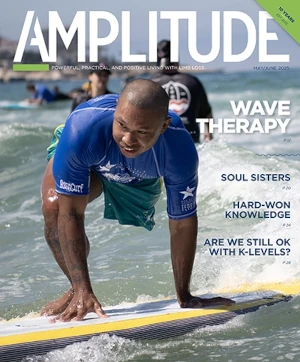Posted February 28, 2014
Max Ortiz Catalan, a doctoral student in the biomedical signals and systems research group at Chalmers University of Technology (Chalmers), Gothenburg, Sweden, has developed a new method for the treatment of phantom limb pain after an amputation. The method is based on a combination of several technologies, including the use of myoelectric signals from the residual limb and virtual reality (VR), and has been initially tested on a patient who has suffered from severe phantom-limb pain for 48 years. A case study shows a significant reduction of pain; the results were published February 25 in the online journal Frontiers in Neuroscience.

Phantom limb pain is currently treated with several different methods. In many cases, however, nothing helps. For example, the study participant lost his arm 48 years ago, and since that time had suffered from phantom-limb pain varying from moderate to unbearable; he was never entirely pain free. His pain was significantly reduced after an 18-week period of treatment with the new method. He now has times where he is entirely free of pain, and he is no longer awakened by intense periods of pain at night, Ortiz Catalan and his coauthors reported.
The new method uses muscle signals from the patient’s residual limb to drive a system known as augmented reality, which provides an enhanced reality, rather than the completely imaginary nature of VR. Electrical signals in the muscles are sensed by electrodes on the skin. The signals are then translated into arm movements through complex algorithms. The patient can see him or herself on a screen with a superimposed virtual arm, which is controlled using his or her own neural command in real time.
“There are several features of this system, which combined might be the cause of pain relief,” said Ortiz Catalan. “The motor areas in the brain needed for movement of the amputated arm are reactivated, and the patient obtains visual feedback that tricks the brain into believing there is an arm executing such motor commands. He experiences himself as a whole, with the amputated arm back in place.”
Modern therapies that use conventional mirrors or VR are based on visual feedback via the opposite arm or leg; for this reason, people who have lost both arms or both legs cannot be helped using these methods. Ortiz Catalan said that his method differs from previous treatment because the control signals are retrieved from the residual limb, and thus the affected arm is in charge. “The promotion of motor execution and the vivid sensation of completion provided by augmented reality may be the reason for the patient improvement, while mirror therapy and medicaments did not help previously,” he added.
A clinical study of the new treatment will now be conducted.
A similar system for home use has also been developed. Patients will be able to apply this therapy on their own once it has been approved. An extension of the treatment is that it can be used by other patient groups that need to rehabilitate their mobility, such as stroke victims or some patients with spinal cord injuries.
Editor’s note: This story was adapted from materials provided by Chalmers University of Technology.



